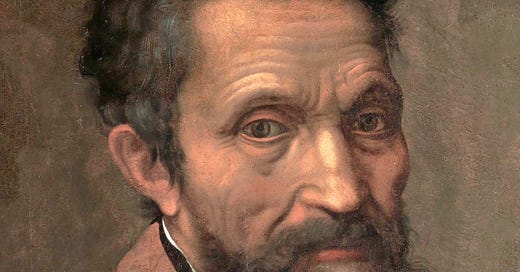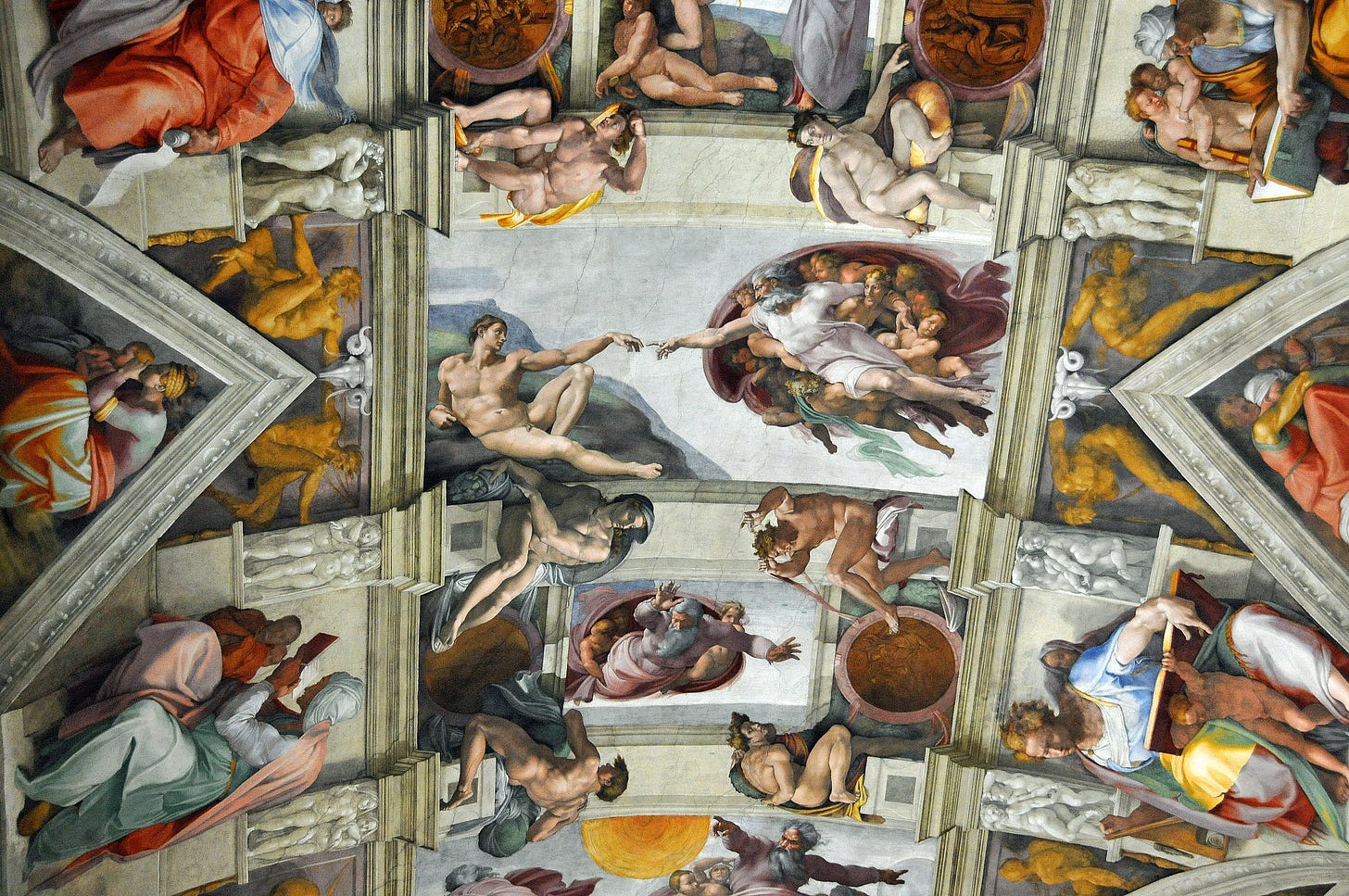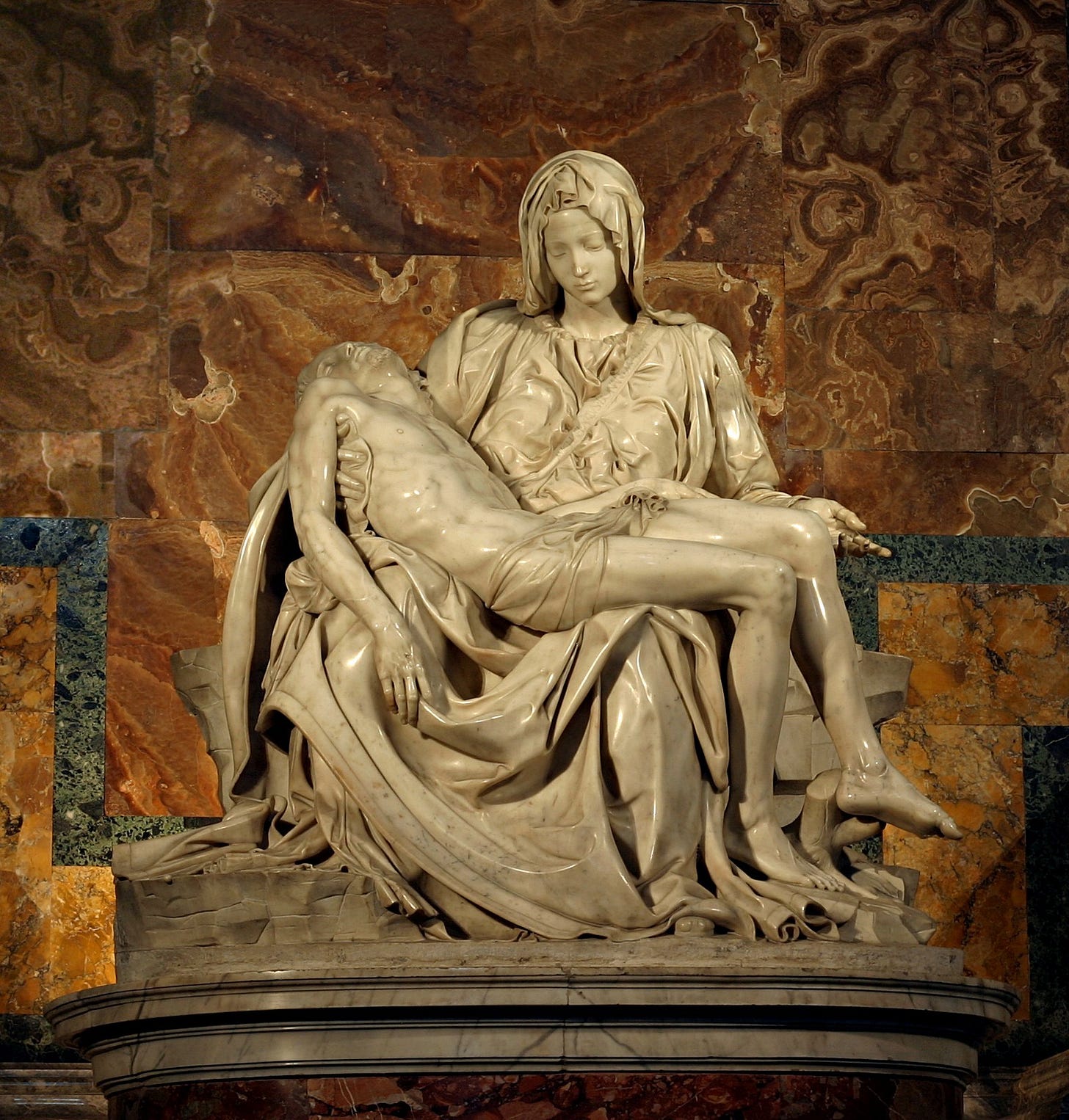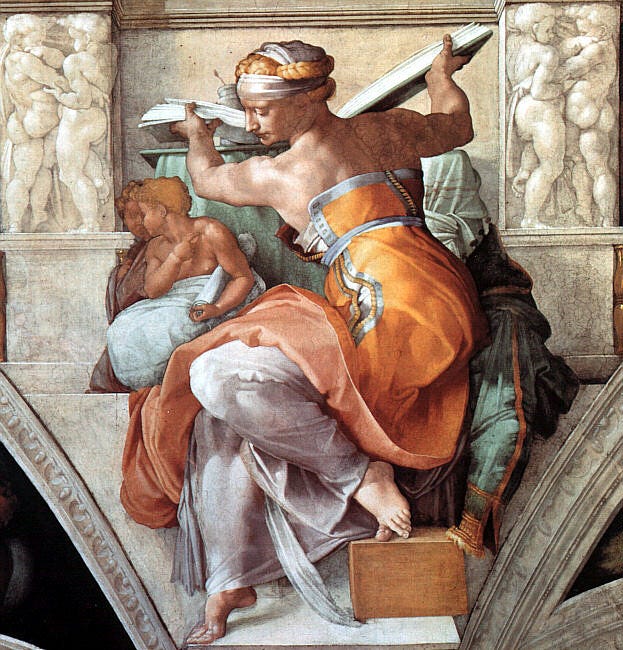Michelangelo Buonarroti: Art and Mental Health History
An unrevised, earlier version of a chapter from The Artist's Mind
This is what an early version of The Artist’s Mind chapter on Michelangelo looked like. If you get the book, you’ll see that for a variety of reasons the chapters were cut down significantly in the editing process so this raw version has a lot more to it … but also perhaps some unnecessary repetition … as compared with the final edited and published version.
“I saw the angel in the marble and carved until I set him free.” - Michelangelo
Michelangelo lived so long ago that it would be impossible to give him an accurate diagnosis. Yet there is enough written about him, and by him, that historians, artists, and doctors have attempted to look back in time to assess his medical condition. Diagnoses have included everything from chronic kidney failure to autism spectrum disorder, but most often professionals have determined that Michelangelo was a soul suffering from depression. Even in terms of the depression itself, this posthumous diagnosis lacks consensus. Jane Kromm writes, “Interpretations have ranged from an extreme, virtually psychotic, melancholia to a general melancholic state of mind affected to indicate creative suffering.” That last phrase goes right to the heart of this book, indicating that for decades, if not centuries, people have, to varying degrees, noticed some type of relationship between mental health and creative impulse.
In any case, in all likelihood, Michelangelo had some degree of depressive mood disorder. Kromm sums it up thusly, “The experiences of Michelangelo that may be construed as evidence of melancholia seem to cluster around several characteristic features. These are a sense of suffering from the harshness of existence, sadness revealed through introspective insight, grief and mourning, love, depression, and ruminative or obsessional concerns.”
Depression, like all mental health issues, has biopsychosocial roots. In other words, it’s the combination of nature and nurture - our brain chemistry, our genetics, and our environment are all contributing factors that can cause depression to manifest. We, of course, cannot know anything about Michelangelo’s brain chemistry since neurochemical studies are only in their infancy today let alone when he was alive, but we do know that both his surroundings and some of the trauma he experienced could have triggered any possible genetic roots of depression to which he may have been predisposed.
For example, we know that Michelangelo was only six years old when his mother passed away. He didn’t even know her well, because his family had followed the practice of the times and had a wet nurse raise him away from the home for most of the first three years of his life. As one might imagine, he was very attached to his wet nurse. Her father and husband were both stonecutters and Michelangelo was known to say that he got his sculptural skills from her. We can only speculate about how devastating it might have been for him to be taken from her at age three and sent back to his parents, only to lose his mother a few years later.
Today we know a lot about the role that early childhood attachment plays in mental health as well as adult relationships. Attachment theory was developed by psychiatrist John Bowlby and further developed by psychologist Mary Ainsworth in the 60s and 70s (and of course has continued to evolve with attention from countless professionals since that time). It’s a comprehensive field of study that would require its own book to fully understand but the gist of it is this: the relationship that we have with our earliest primary caregiver (usually a mother but of course this could be a person of any gender, an in Michelangelo’s case seems to be his wet nurse) sets the blueprint for how we react in all future relationships. The ideal is that your caregiver meets all of your needs but also allows you to become self-sufficient and thus you end up a healthy adult with secure attachment. Most people, however, have one of the three forms of insecure attachment: anxious, ambivalent, or avoidant. The simplified explanation is that children whose needs aren’t met become anxious/needy, children who grew up around rage, hostility, or trauma become avoidant in relationships and have trouble attaching to others, and children who got mixed messages become ambivalent, often confused about what they want in relationships. What kind of attachment message did Michelangelo receive when his mother gave him to a wet nurse who then had to give him back at age three to a mother who died only three years later?
Despite these early and likely confusing losses, Michelangelo thrived in his life in many ways. He began his art career young and showed much promise. Although his father wished for him to pursue a more professional career, he insisted on being an artist, first apprenticing under Ghirlandaio to learn fresco painting and then, by age 15, securing a job as a sculptor with the Medici family. Notably, however, this would lead to more devastating losses in his young life. Lorenzo de’ Medici died in 1492, when Michelangelo was still in his late teens and the artist was filled with sorrow and anguish and found himself unable to work for a time (although notably after a short time he did pour that grief into his art, creating a Hercules statue.)
And yet, although his career flourished, Michelangelo likely struggled emotionally from a very young age. One particular area of life that was emotionally problematic for him was love and sexuality. This could be related somewhat to attachment issues. But he also semed to battle internally with guilt and shame about homosexual feelings that were considered terribly sinful in the very Catholic society of Renaissance-era Italy. Mostly undiscussed in his lifetime, Michelangelo’s sexual orientation is up for debate, but it’s been widely argued that he was a gay male struggling with religious concerns about his feelings. Did these feelings perhaps come out in his art? Some say that his male nude statues are detailed and passionate, while his female characters tend to be expressionless. Towards the end of his very long life, he collaborated with a pupil to write his biography, and in it he carefully alludes to the situation. He talks about how the end of the 15th century, when Michelangelo was a teenager coming into his own secuality, there existed much tension between two competing viewpoints: the Platonic Academy’s faithful followers believed in the beauty of the male body (particularly young male bodies, as influenced by the Greek) and the followers of Dominican friar Girolamo Savonaro who campaigned against nudity and “sodomoites.”
Understanding his sexuality is complicated by the fact that it was not only repressed in his lifetime, but also that there were different interpretations of orientation then than there are today. More often his work and writings point to total abstinence or even repulsion by sexuality. Michelangelo seemed indifferent to women, and it’s unknown whether he ever had sex in his lifetime. The only indication of any sort of passionate relationship is with “Tommaso de’ Cavalieri, a young Roman nobleman for whom he developed a powerful infatuation.” He was in his late fifties, de’ Cavalieri was in his early twenties, and Michelangelo wrote him hundreds of letters and poems expressing his love. Over time, historians have argued whether this was simply platonic brotherly love or more passionate love. Perhaps Michelangelo himself wasn’t sure.
We can’t really know what turmoil, if any, Michelangelo’s sexuality added to his life, but it certainly couldn’t have been an easy situation to navigate given the time in which he lived. In the aforementioned biography, it notes that sixty years after his exposure to the conflict between aesthetic appreciation of the male body and the idea of sexuality and nudity as Catholic sins, he still struggled to reconcile that conflict. The best solution he could come up with was an interpretation of Plato’s teachings that “not only condoned the love of men but in the Phaedra made it a transcendent value, while demanding a celibacy consistent with Christian teaching.”
Michelangelo went back and forth in his artwork in regards to reconciling this issue. Biographer Louis Compton notes several examples such as his 1494 works: the Proculus statue is of a local saint “whose furrowed brow is an image of adolescent anxiety” and the same year he created “his first masterpiece and most voluptuous male nude, the drunken Bacchus, whose dangling grapes are nibbled by a mischievous boy-satyr.” Compton also asks that we look closely at two of Michelangelo’s most famous works: the David and the Pieta, noticing how each of these include both pagan aesthetics and appreciation of Eros as well as Christian aesthetics and appreciation of Faith.
This attempt to reconcile two very different belief systems, potentially tied up in his own sexuality, pervaded Michelangelo’s life. This, as well as pressing, immediate stressors related to his work, may have combined with a genetic predisposition to depression and contributed to major depressive periods throughout his lifetime. Though creating art may have been cathartic, the professional pressures of the actual job may also have been a source of stress for him. In fact, he often took objectively longer than necessary to complete his works, sometimes not finishing them at all. This seems to have been, at least at times, a direct result of the lethargy and self-doubt that come along with depression, which can create a cycle when the unfinished work leads to further ruminating thoughts that exacerbate the depression. As an example, let’s go back to the Florentine Pieta. He worked on the sculpture for eight years and, in the words of one biographer, “...poured his depression over his life into the statue.” Depression can feel ugly, and whether or not the work was objectively reflecting that, Michelangelo finally got so frustrated with what he perceived as the dismal results of his labor that he murdered the statue with a chisel. Sculptor Tiberio Calcagni finished that piece for him. It’s worth adding that historians believe he carved his own likeness into Saint Nicodemus in that statue, which begs the question of whether he was murdering a part of himself when he attacked that statue
Of course, Michelangelo may be best recognized for painting the ceiling of the Sistine Chapel. However, the world is lucky he managed to complete the magnificent mural at all. Letters indicate that he dragged through the work in a state of exhaustion and depression. It probably didn’t help matters that the artist didn’t enjoy painting; he considered himself a sculptor and took painting commissions in order to pay the bills. Many working artists will recognize this struggle to find a balance between working creatively and working for financial stability, and artists who struggle with mental health issues may find this balance to be particularly precarious. Biographer Martin Gayford notes that, in times of deep depression, Michelangelo would often give in to fatigue and opt not to work on projects that didn’t add to his life positively, even though it meant giving up money. In other times, he would feel compelled to take on those jobs even though they stressed him out and exacerbated his mental health issues.
Michelangelo started the Sistine Chapel in 1508. By 1512, Pope Julius, afraid he wouldn’t see the ceiling painted before his own death, pestered the artist almost daily for updates on its progress, but to no avail. Michelangelo complained to the Pope, often describing physical ailments that may or may not have been symptoms of his mental state. Depression often manifests in physical illness: headaches, gastrointestinal distress, fatigue, insomnia and body aches are a few common examples. Michelangelo, despite being a strong 33 year old when he started the project, “complained of aches, discomfort, tired bones, and feeling old.” And it’s been widely documented in biographies about him that he had difficulties or eccentricities around both eating and sleeping habits. That sounds like possible symptoms of depression. He would have continued trying to perfect the painting if the Pope hadn’t said “enough is enough” and declared it done. Ironically, the Sistine ceiling is the work he’s best known for, and yet he seemingly detested every minute of its creation.
Although Michelangelo is best known for his work in the visual arts, he was also a prolific poet. One of his poems, the unfinished canzone, laments the sadness of time lost. Some believe that the poem is a reflection of the depression that he felt during the three years he felt were wasted creating the facade of the Basilica of San Lorenzo.
The poem begins:
“What’s to become of me? What’s this you’re doing
to my charred old heart you’ve made such ashes of?
Suppose you tell me, Love,
so I’ll know how it stands with me, what trouble’s brewing.”
And goes on later to say:
“No ordeal lasts when age begins to tell.
That’s why I seem like ice the flames enwrap:
It shrinks, writhes to escape, but won’t invite.
I’m old. My sole defense is death, whose might
Can ward off your brutal arm, your barbs that rain
Their piercing pain on pain.”
Many of Michelangelo’s sonnets also reflect his lifelong battle with depression. Consider this excerpt:
“I'm envious, Love, I swear
(why hide it?) of the dead,
a panicky muddle-head,
my soul in terror of its sensual tie.
Lord, as the last hours fly,
stretch out in mercy your two arms; make me
less what I've been, more what you'd have me be.”
Furthermore, the artist gave many hints regarding his mental state in his written correspondence. He once told an artist friend in a letter that he was unable to work due to “mal sano,” a phrase that could simply mean poor health but just as easily could be indicating poor mental health. Other times he explicitly names his depression, as in this 1525 letter: “several other gentlemen kindly invited me to go and have supper with them, which gave me the greatest pleasure, as I emerged a little from my depression, or rather from my obsession. I not only enjoyed the supper, which was extremely pleasant, but also, and even more than this, the discussions which took place.”
From what we can surmise, Michelangelo appears to be a quintessential example of an artist who created great works in the face of depression. In some instances, perhaps, the work itself reflects his depression. For example, David can be analyzed through the lens of an artist creating a piece about “an ambiguous, unfulfilled, emotionally tense moment in the hero’s career” that mirrors the artist’s own mind at the time. Battle of Cascina perhaps “gave Michelangelo the ‘opportunity of projecting … the emotional stresses of his early existence.’” So perhaps depression gave him insights into human emotion that allowed him to create powerful pieces. But, it’s worth asking, might he have done even more creatively if depression hadn’t been holding him back? Who knows what masterpieces he could have accomplished without the exhaustion and self-flagellation that came along with a depressed mind?
Despite this, he lived to be almost ninety years old during an era when men rarely made it to age fifty, and he worked as an artist for the duration of his lifetime. That’s a prolific lifetime of dedication to art. Kromm notes that depression often saps people of the energy to create, and that this was rarely the case for Michelangelo (although it did occur at times). Her position is that perhaps he then didn’t have depression in the way that we understand it today. However, we could also look at this through the lens of spectrums discussed in this book’s introduction: Michelangelo likely existed somewhere along the depression / mental health spectrum, clearly exhibiting some distressing symptoms. As a prolific lifelong career artist who insisted upon making art as a child despite his father wishing differently, he seems to exist on the “compelled to create” side of the artistic spectrum. So when we layer one spectrum over the other, one conclusion could be that he was so driven to create art that he was able to do so fairly steadily throughout his lifetime in spite of his depressive symptoms. Maybe his artistic drive helped to ease some of those symptoms or maybe he pressed through the symptoms because he was so committed to his own creativity.
Closer Look: Art For Thought
Let’s take a closer look at Michelangelo’s Pieta through a mental health lens. As already mentioned in the chapter, the piece incorporates both Christian and pagan aesthetic ideals, honoring both Faith and Eros in what might have been a lifelong attempt to reconcile the two. Artists often have particular themes, frequently reflecting thoughts and beliefs that they’re trying to work through over time, and this may have been the one that occupied Michelangelo most through this lifetime.
The Pieta, a theme of which he repeated over and over again in his sculptures, is the depiction of a young Mary holding a fully-grown Jesus. There are countless interpretations of this. From an art history perspective, the result was unique proportionality to the sculpture because of the logistical issues of positioning a fully grown man held like a baby in a smaller woman’s arms. It’s intriguing from an art and design perspective because Mary’s head seems in the correct proportion while her body has been enlarged to hold her grown son. From a mental health perspective, can we ignore the influence of Michelangelo’s early years on this work? Did he make the unique choice of selecting a very young Mary because his memories of his own mother end with her death at his age of six? How did his experience of early maternal loss impact his interpretation of the story he tells through this piece? What can we draw from the fact that her son’s weight looks so very heavy on her lap? Is that only the heaviness of grief or is Michelangelo’s own heaviness coming through the work? Hone in on the way that her hand seems to strain to hold up his flesh; it’s pure exertion. Depression can make any aspect of life feel like it requires such exertion.
Look at the intense emotion carved into the piece. Look at the sadness carved so intensely upon Mary’s face. Of course this reflects her grief over the loss of her son. But is it a reflection of Michelangelo’s emotions? Depression can be numbing but there are also times when it makes emotions so incredibly intense. And note that Christ looks serene. Many artist’s depictions of this scene are gruesome with huge bloody marks for the crucifixion and pain on his face. And yet Christ is barely marred, there is no gore, and his face looks at peace. We know from Michelangelo’s writings, like the poem excerpt shared before, that he sometimes idealized death. In addition to all of the religious connotations of the piece, this is also a sculpture of a young man resting peacefully in death while his sweet, but anguished, young mother holds up the weight of him. Is it meaningful in any way that this sculpture, which ultimately was the first to gain him true fame as an artist, was the only one that he ever signed?
Michelangelo captures so much emotion in this piece (as he did in so much of his other work, too.) Did his experience of depression, loss, and struggle give him a unique perception into pain, emotion, and humanity that he was able to then so powerfully convey through his art? Without the unique ways that his brain worked, including the depressive periods he endured, would he have created works that touched so deeply on these aspects of universal human emotion? These questions have no clear cut answers, but if we explore them from multiple perspectives, perhaps we can all gain further insight into the way that artistic impulse and mental health work forwards and backwards with one another in an artist’s lifetime.
EXTRA FACTS OF INTEREST
The Sistine ceiling was executed on freshly laid plaster, and only a small area of the fresco could be completed each day before it dried. Each little chunk was known as a "giornata," meaning a day's work. It took Michelangelo four years to complete.
Several famous writers attempted to translate Michelangelo’s poems but often found it challenging to do so. Wordsworth said it was “the most difficult to construe I ever met with.” Translations were also attempted by Emerson, Longfellow, Santayana, and Rilke.
Artist Kathe Kollwitz, who also lived with depression, was originally inspired by Michelangelo’s Pieta for her 1903 series “woman with dead child.” Kollwitz’s had three siblings who died and her own mother become “emotionally dead as a result.” So, although she didn’t lose her mother to actual death at a young age like Michelangelo did, she lost her emotionally. Could these experiences have influenced both artists to create such powerful sculptures of mothers grieving their children?
*All works cited available upon request
If you read this far, perhaps you liked the work. The work does take work. It only continues with support, so please consider subscribing. My annual rate starts at $10 per year.













This gives me so much to think about. I see so much in common with my depression and my need to create and not being able to. Perhaps those of us with depression feel these emotions deeper than others because we tend to dwell more on our obsessions. All our emotions are not all negative when you have depression. I still can find comfort and almost relief during the process of creating, taking the mind away from troublesome thoughts, but with fatigue it is harder to initiate the act of creation.
I think if I were to send hundreds of letters of love to one person, there would be no doubt that it was passionate love rather than platonic. Sheeese. 🙄
1. I was fortunate enough to see some of the great works by Michelangelo when I visited Florence and Rome a few years back. They are amazing to see in real life! Except the Sistine Chapel, which was just really, really far away and hard to see. The internet has spoiled me.
2. I wrote about the Medici and Michelangelo today, too! My piece only mentions them to support a central theme, but still... great minds!